| Irradiation induced Crystallization |
| Irradiation induced Crystallization |
![]()
Table 1 The occurrences of MeV-electron irradiation-induced crystallization (amorphous-to-crystal transition) reported to date [1,2]. Experimental data at 298 K obtained using an HU-2000 or H-3000 UHVEM at Osaka University. The irradiation was performed at 298 K with a dose rate of the order of 1024 m-2s-1. (Updated on 09/01/2014) 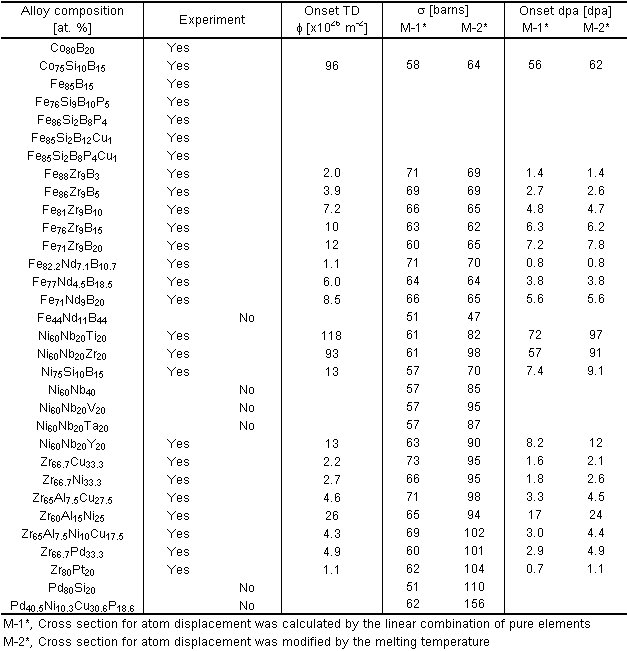 Reference [1] T. Nagase (Contribution): Advanced materials design by irradiation of high energy particles, in: Progress in Advanced Structural and Functional Materials Design, Ed., T. Kakeshita, Springer, 2013. pp. 137-153. ISBN 978-4-431-54063-2 http://www.springer.com/materials/structural+materials/book/978-4-431-54063-2 [2] T. Nagase, T. Sanda, A. Nino, W. Qin, H. Yasuda, H. Mori, Y. Umakoshi, and J.A. Szpunar: J. of Non-Cryst. Solids, 358, 502-518 (2012). http://dx.doi.org/10.1016/j.jnoncrysol.2011.11.010 |
MeV electron irradiation can introduce irradiation defects in an amorphous phase, resulting in the devitrification (crystallization) of an amorphous phase (amorphous-to-crystal transition) in some metallic glasses, while it can bring about the collapse of the crystalline structure (SSA). The enhancement and stimulation of the thermal crystallization by electron irradiation had been found at 1970s and 1980s. The irradiation induce crystallization at significantly lower temperature than the thermal crystallization temperature (room temperature) was found in Fe88Zr9B3 amorphous alloy [3]. The irradiation induced crystallization of an amorphous phase in metallic glass with wide supercooled liquid region was also found in Zr-based metallic glasses [4-6], As shown in the review papers [7, 8], a lot of melt-spun metallic glasses were crystallized by electron irradiation at an acceleration voltage of 2.0 MV at room temperature. Irradiation-induced crystallization under MeV electron irradiation with a high dose rate (over 1023 m-2s-1) is commonly observed in metallic materials. REFERENCE [1] J. L. Brimhall, J. Mater. Sci. 19 (1984) 1818-1826. [2] M. Doi, M. Yoshida, M. Nonoyama, T. Imura, T. Masumoto, Y. Yashiro, Mater. Sci. Eng. 23 (1976) 169-172. [3] T. Nagase, Y. Umakoshi, N. Sumida, Mater. Sci. Eng. A 323 (2002) 218-225. http://dx.doi.org/10.1016/S0921-5093(01)01351-X [4] T. Nagase and Y. Umakoshi: Sci. Tech. Adv. Mater., 3, 119 (2002). http://dx.doi.org/10.1016/S1468-6996(02)00013-X [5] T. Nagase and Y. Umakoshi: J. Appl. Phys., 93, 912-918 (2003). http://dx.doi.org/10.1063/1.1529073 [6] T. Nagase and Y. Umakoshi: Mater. Trans., 45, 13-23 (2004). http://www.jim.or.jp/journal/e/45/01/13.html [7] T. Nagase (Contribution): Advanced materials design by irradiation of high energy particles, in: Progress in Advanced Structural and Functional Materials Design, Ed., T. Kakeshita, Springer, 2013. pp. 137-153. ISBN 978-4-431-54063-2 http://www.springer.com/materials/structural+materials/book/978-4-431-54063-2 [8] T. Nagase, T. Sanda, A. Nino, W. Qin, H. Yasuda, H. Mori, Y. Umakoshi, and J.A. Szpunar: J. of Non-Cryst. Solids, 358, 502-518 (2012). http://dx.doi.org/10.1016/j.jnoncrysol.2011.11.010 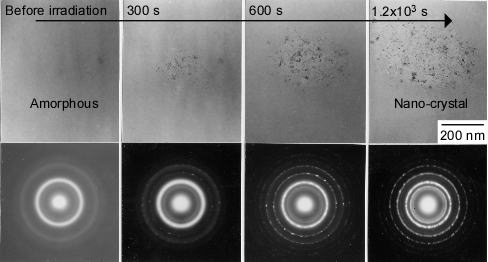 Figure 1 Typical example of MeV electron irradiation induced crystallization of an amorphous phase. Fe-9Zr-3B, 2.0 MV, 298 K, 1.7x1024 m-2s-1 [3]. |
Free volume like defects and Anti Free like defects Under MeV electron irradiation, only single or, at most, double atom displacements of constituent elements can occur by the knock-on mechanism. Figure 1 shows a schematic illustration of the atomic defects in single-element crystalline and amorphous phases introduced by the electron knock-on effect. In the crystalline phases (a), not only a vacancy but also an interstitial is introduced under the irradiation, where the existence of an interstitial can be ignored in materials without irradiation. A vacancy type of a free volume like defect and an interstitial type of anti free volume like defect [1-4] are introduced in an amorphous phase under the irradiation (b). Figure 2 shows the schematic illustration of the defects in multi-component amorphous alloy. One can notice that many type defects can be considered in an amorphous phase. The concept of two-type defects is important for clarifying the mechanis of the irradiation induced crystallization of an amorphous phase. REFERENCE [1] T. Egami, K. Maeda, D. Srolovitz, V. Vitek.: J. Phys. 41, C8-272-C8-275 (1980) [2] Y. Petrusenko, A. Bakai, V. Borysenko, A. Astakhov, D. Barankov, Intermetallics 17, 246-248 (2009). [3] T. Nagase, T. Hosokawa, Y. Umakoshi: Intermetallics 18, 767-772 (2010) http://dx.doi.org/10.1016/j.intermet.2009.12.003 [4] T. Nagase, Y. Umakoshi: Intermetallics 18 1803-1808 (2010) http://dx.doi.org/10.1016/j.intermet.2010.02.044 [5] T. Nagase (Contribution): Advanced materials design by irradiation of high energy particles, in: Progress in Advanced Structural and Functional Materials Design, Ed., T. Kakeshita, Springer, 2013. pp. 137-153. ISBN 978-4-431-54063-2 http://www.springer.com/materials/structural+materials/book/978-4-431-54063-2 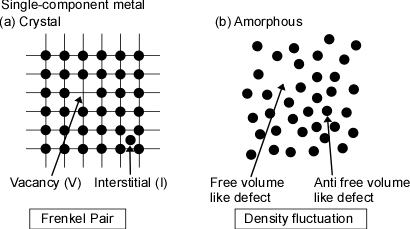 Figure 1 Schematic illustration of defects in single-component metal system produced by single-atom displacement [3-5]. 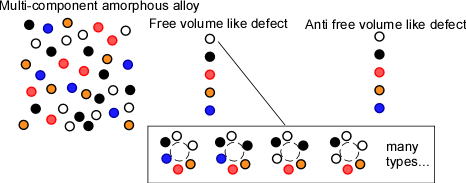 Figure 2 Schematic illustration of defects in multi-component amorphous alloy produced by single-atom displacement [5]. |
The ordered array nano-crystallization area whose diameter is about 1 mm can be realized by MeV electron irradiation indcued crystallization tecnique by use of High Voltage Electron Microscope [1,2] REFERENCE [1] T. Nagase, A. Nino and Y. Umakoshi: Mater. Sci. Forum., 561-565, 1402-1406 (2007). http://dx.doi.org/10.4028/www.scientific.net/MSF.561-565.1403 [2] T. Nagase: Materia Japan, 49, 323-324 (2010). (in Japanese) http://dx.doi.org/10.2320/materia.49.323 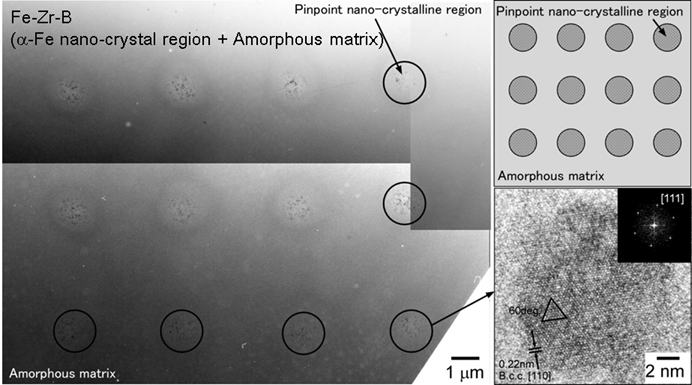 Table 2 Pinpointe nanocrystallization of an amorphous phase in Fe-9Zr-3B alloy [1,2]. |